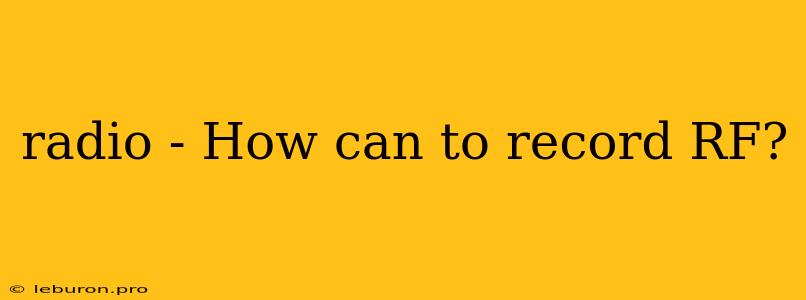Recording Radio Frequencies: A Guide for Beginners and Enthusiasts
Radio waves are everywhere, carrying information from our favorite music stations to critical communication signals for emergency services and aviation. For those interested in exploring the unseen world of radio frequencies, recording them offers a fascinating glimpse into the dynamic tapestry of electromagnetic energy that surrounds us. This guide will delve into the basics of radio frequency (RF) recording, covering essential equipment, software, and techniques, all while emphasizing safety and ethical considerations.
Understanding Radio Frequencies
Before delving into the technicalities of recording RF, it's crucial to grasp the fundamental concept of radio waves. These waves, part of the electromagnetic spectrum, travel at the speed of light and carry information through variations in their frequency. The frequency, measured in Hertz (Hz), determines the type of signal being transmitted, ranging from low-frequency radio waves used for communication to high-frequency microwaves used in ovens.
Essential Equipment for Recording RF
Recording radio frequencies requires specialized equipment that can capture and process the electromagnetic signals. The core components include:
- Software-Defined Radio (SDR) Receiver: SDRs are the workhorse of RF recording. These devices can tune across a wide range of frequencies and digitally process the captured signals, allowing for versatile analysis and recording.
- Antenna: An antenna acts as the bridge between the radio waves and the SDR receiver. Different types of antennas are optimized for specific frequency bands, so choosing the right one is essential for optimal signal reception. Common antenna types include whip antennas, dipole antennas, and loop antennas.
- Computer: A computer is essential for running the SDR software and storing the recorded data. The computer should have sufficient processing power and storage capacity to handle the data flow from the SDR receiver.
- Recording Software: Specialized software, often bundled with SDR devices, is used to capture, decode, and analyze the recorded RF signals. Popular options include SDR# and HDSDR, which offer a wide range of features and customization options.
Recording Techniques: A Step-by-Step Guide
- Set Up the Equipment: Connect the SDR receiver to your computer and choose an appropriate antenna based on the frequency range you wish to record. Ensure the antenna is positioned for optimal signal reception, often requiring experimentation to find the ideal location.
- Tune the SDR Receiver: Use the recording software to set the SDR receiver to the desired frequency range. Experiment with different frequencies to explore the spectrum and identify interesting signals.
- Start Recording: Begin recording using the recording software, specifying the recording duration and file format. Most software offers options for saving recordings in various formats, including WAV, MP3, and custom formats for specific applications.
- Analyze and Decode the Recording: After recording, use the software's decoding features to analyze the captured signals. This may involve identifying the type of signal, decoding the data, and extracting information from the recording.
Legal and Ethical Considerations
Recording radio frequencies comes with legal and ethical considerations. It's essential to understand the regulations and potential consequences associated with recording specific frequencies. Always consult relevant regulations and avoid recording signals that could potentially violate privacy or national security protocols.
Conclusion
Recording radio frequencies offers a fascinating opportunity to explore the world of electromagnetic waves and the information they carry. By following this guide and adhering to legal and ethical guidelines, individuals can embark on a journey of discovery, unraveling the mysteries hidden within the electromagnetic spectrum. Remember, responsible use, ethical considerations, and respect for privacy should always guide your exploration of the radio frequency world.
